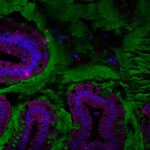Link to Pubmed [PMID] – 32387380
Link to DOI – 10.1016/j.exer.2020.108059
Exp Eye Res 2020 Jul; 196(): 108059
Structure and function of the retina mainly rely on its fatty acid (FA) composition. Evidence from epidemiological studies and from animal experiments indicates that FA composition of the retina is influenced by the diet. Mice under chronic high-fat diet (HFD) develop metabolic syndrome, a risk factor for diabetes that is associated with structural and functional alterations of the retina. Here, we studied the impact of chronic exposure of mice to HFD on retinal FA composition. C57BL/6 J male mice were fed either a chow diet or a HFD for 11 weeks. As expected, HFD induced weight gain, adiposity, hyperglycemia and dyslipidemia. The retinal FA composition was determined by gas chromatography coupled to flame ionization detection. No significant change in the relative abundance of total saturated FAs (SFAs), total monounsaturated FAs (MUFAs) or total polyunsaturated FAs (PUFAs) was observed. However, retinas of HFD-fed mice displayed decreased amounts of C24:0 (p = 0.0231), C16:1n-7 (p < 0.0001), C18:1n-7 (p < 0.0001), C20:3n-9 (p = 0.0425) and C20:3n-6 (p = 0.0008), and an increased amount of C20:2n-6 (p < 0.0001). In addition, the ratio of linoleic acid (C18:2n-6) to alpha-linolenic acid (C18:3n-3) was increased in the retinas of HFD-fed mice (15.0 ± 0.8 versus 11.8 ± 0.6 in HFD and CD, respectively, p = 0.0045). No modification in the contents of arachidonic acid (C20:4n-6, AA) and docosahexaenoic acid (C22:6n-3, DHA) were observed. Analysis of dimethylacetals (DMA), which are residues of plasmalogens (Pls), revealed that the amount of Pls containing octadecanal-aldehydes (DMA C18:0) was significantly increased in HFD-fed mice (p = 0.0447). This increase was, at least in part, balanced by a decrease in Pls containing 7-octadecanal-aldehydes (DMA C18:1n-7) (p = 0.0007). In conclusion, HFD had an impact on the relative proportion of essential dietary fatty acids linoleic acid and alpha-linolenic acid that are incorporated in the retina. However, this imbalance in PUFA precursors did not alter the content of the two major retinal long-chain PUFAs, AA and DHA. HFD consumption also led to alterations in the retinal SFAs, MUFAs and Pls profiles.


